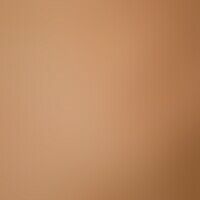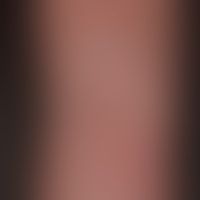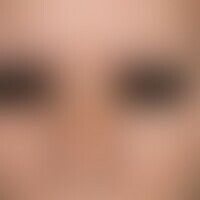Image diagnoses for "brown"
373 results with 1439 images
Results forbrown

Necrobiosis lipoidica L92.1
Necrobiosis lipoidica: confluent, reddish-brownish, reddish-brownish, centrally clearly atrophic, bruan-red plaques that have been present for about 3-4 years, gradually increasing in size, sharply defined, confluent, reddish-brownish, centrally clearly atrophic, bruan-red plaques, increase in consistency over the entire plaque.

Fixed drug eruption L27.1
Drug reaction, fixed: suddenly appeared, reddish-brownish, roundish, sharply defined, hardly infiltrated plaques, existing for a few days. 20-year-old female patient. Probably drug-induced cause: paracetamol.

Verruca vulgaris B07
Verrucae vulgares (detailed picture): flat wart bed with subungual infiltration. This constellation results in considerable therapeutic complications. It is important to exclude a verrucous carcinoma.

Nevus spilus L81.4
Naevus spilus, a light brown large pigmentation spot with splashes of dark pigmentation that has existed since birth (Lapwing's nevus).

Papillomatosis cutis lymphostatica I89.0
Papillomatosis cutis lymphostatica: massive findings with papillomatous growths on the thighs; massive chronic lymphedema with deep folding of the skin above the heel region.

Mycosis fungoides C84.0
Mycosis fungoides: massive onychogrypose with extensive infestation of the integument

Maculopapular cutaneous mastocytosis Q82.2
Urticaria pigmentosa: Close-up: about 0.5-1.0 cm in size, disseminated, oval or round, brownish-red spots; "Darier phenomenon" can be triggered; here visible by the red colour in places of slight mechanical irritation.

Sarcoidosis of the skin D86.3
sarcoidosis: anular or circine chronic sarcoidosis of the skin. existing for about 5 years. onset with papules the size of a pinhead (see middle of the cheek) with appositional growth and central healing. no detectable systemic involvement. findings: asymptomatic, brown to brown-red, borderline, centrally atrophic, little infiltrated, confluent lesions in the face in several places.

Nevus verrucosus Q82.5
Hyperkeratotic papules in linear arrangement from the left distal lower leg to the buttocks in a 15-year-old adolescent.

Kaposi's sarcoma epidemic C46.-
Kaposi sarcoma epidemic or HIV-induced: Disseminated flat reddish-brown, surface smooth, symptomless plaques, characteristically located in the tension lines of the skin.

Tinea corporis B35.4
Tinea corporis: unusually elongated, large-area tinea corporis, pretreated for several months with a potent corticosteroid steroid externum; distinct itching on interruption of steroid therapy (existing for 8 months).

Keratosis areolae mammae naeviformis Q82.5
Keratosis areolae mammae naeviformis: painless nipple-like change of both nipples, existing since puberty.

Verruca vulgaris B07
Verrucae vulgares. up to 0.6 cm in size, skin-coloured to yellowish, chronic, rough papules and nodules with a verrucous surface.

Basal cell carcinoma (overview) C44.-
Basal cell carcinoma (overview): Basal cell carcinoma superficial, detailed view.

Pagetoid reticulosis C84.4
Reticulosis pagetoid, disseminated type (Ketron and Goodman). progressive clinical picture existing for years. multiple, red, rapidly growing, rough (scaly) plaques. itching

Purpura pigmentosa progressive L81.7
Purpura eczematide-like purpura: non-symptomatic (no itching) "eczema-like" disease that has been recurrent for months in a completely healthy patient (no history of medication).

Diffuse cutaneous mastocytosis Q82.2
diffuse cutaneous mastocytosis, with uniform waxy skin texture and artificial (subepithelial) blistering. peau-dórange-like skin aspect. detailed view.

Adenoma sebaceum Q85.1
Adenoma sebaceum: in the 65-year-old female patient, skin-coloured to reddish-brownish, densely packed papules and plaques with centrofacial accentuation have existed since childhood; the misleading term "Adenoma sebaceum" refers to the characteristic centrofacially localised angiofibromas occurring in the context of tuberous sclerosis complex (Pringle-Bourneville phacomatosis).






